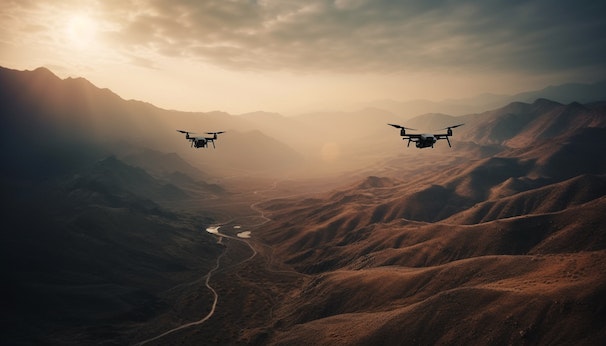
The Sky’s the Limit: Why 2024 Was the Year of Escalating Drone Threats
December 9th, 2024In 2024, the skies became a hotbed of drone activity like never before. With over 1.1 million drones registered in the U.S. and the FAA fielding more than 100 drone-related reports every month, the risks associated with uncrewed aerial systems (UAS) skyrocketed to new heights.
This year made one thing crystal clear: drones are no longer harmless toys buzzing around parks—they’ve become serious threats capable of breaching events, surveilling critical infrastructure, and disrupting lives. Many organizations, however, remain unprepared for the rapidly evolving challenges posed by these airborne intruders. The need for robust drone detection and countermeasure systems has never been more urgent.
Let’s dive into some of 2024’s most eye-opening drone incidents, which highlight just how vulnerable we are—and how vital it is to take action before it’s too late.
Notable drone incidents that shaped 2024
The following cases serve as stark reminders of what’s at stake when organizations fail to proactively counter drone threats. As we move toward 2025, it’s clear that counter-drone strategies are no longer optional—they’re essential.
Drones and critical infrastructure: A growing threat to essential systems
Attempted attack on a power grid in Tennessee
One of the most alarming drone threat examples of 2024 occurred in Nashville, TN where federal authorities foiled a plot to attack an electric substation using a drone armed with explosives. The suspect, driven by white supremacist ideology, aimed to disrupt power to thousands just days before the U.S. presidential election. This incident highlights the increasing sophistication of drone-based threats and underscores the urgent need for advanced counter-drone technologies to safeguard critical infrastructure.
Mystery drones over New Jersey
Over just the last few weeks, mysterious drone sightings across several New Jersey counties have sparked an investigation involving local law enforcement, the FBI, and the FAA. The drones disrupted a medevac helicopter’s emergency landing and triggered flight restrictions around sensitive areas, including the Picatinny Arsenal Military Base. Despite extensive efforts, the operators remain unidentified, highlighting the need for advanced drone detection and forensics systems.
Sports and entertainment: When the games stop because of drones
NFL game halted by a drone swarm
The year kicked off with an unexpected timeout during the Ravens vs. Chiefs game at M&T Bank Stadium. Five drones were spotted within a 3-mile radius, breaching FAA no-fly zones and forcing the game to stop. Although authorities eventually located the drone operator, their motives remain unclear. This incident underscored the need for stadiums to implement proactive counter-drone measures, such as identifying entry points and deploying countermeasures before disruptions occur.
Paris Olympics: Spy games in the sky
During the 2024 Olympics, the Canadian women’s soccer team was caught using a drone to spy on U.S. and New Zealand teams’ training sessions. This brazen move exposed vulnerabilities in sports intelligence security and highlighted the value of technologies like radio frequency (RF) detection to catch unauthorized drones before they can exploit sensitive situations.
Green Day concert chaos
In September, thousands of fans at Comerica Park in Detroit were left stunned when an unauthorized drone buzzed the stage during a Green Day concert. The band was forced to flee mid-performance, and the event was paused for ten tense minutes until authorities detained the operator. This incident underscored how a single drone can disrupt large-scale events, posing safety risks for both performers and audiences.
Intelligence gathering: Espionage has taken to the skies
Spying on submarines
Early in the year, a Chinese national used a drone to capture images of nuclear submarines being assembled in the U.S., exposing the alarming reality of aerial espionage. This was a chilling reminder that drones are more than nuisances—they are tools for high-stakes intelligence theft.
Drone scouting before an assassination attempt
In Pennsylvania, a drone was reportedly used to scout the Butler Farm Showgrounds before a rally for former President Donald Trump. This pre-attack surveillance demonstrated how drones can be weaponized to gather intelligence for criminal or even life-threatening purposes.
Looking ahead: Why counter-drone solutions are critical
From sporting events to national security sites, drones demonstrated in 2024 how easily they can disrupt operations, gather intelligence, and compromise safety. And as drone technology evolves, so too do the potential threats of drones—and the tactics of bad actors exploiting these systems.
But it’s not all doom and gloom. Drones also present opportunities, particularly in public safety. By 2027, Gartner predicts that 50% of public safety organizations with more than 200 officers will use drones as first responders. However, with the good comes the bad—and the rapid increase in drone usage also means heightened risks from criminal operators.
The solution? Real-time drone detection and analytics capabilities. These are no longer luxuries—they’re necessities.
Stay ahead of drone threats with SkySafe
SkySafe’s cloud-based drone detection software empowers organizations to take control of their airspace, providing the tools they need to detect, identify, and neutralize drone threats. As we step into 2025, there’s no better time to upgrade your defense strategy and ensure your operations, events, and critical assets remain secure.
Don’t wait for the next disruption—take action today. Schedule a demo with SkySafe to see how we can help you outsmart drone threats and safeguard your future.
